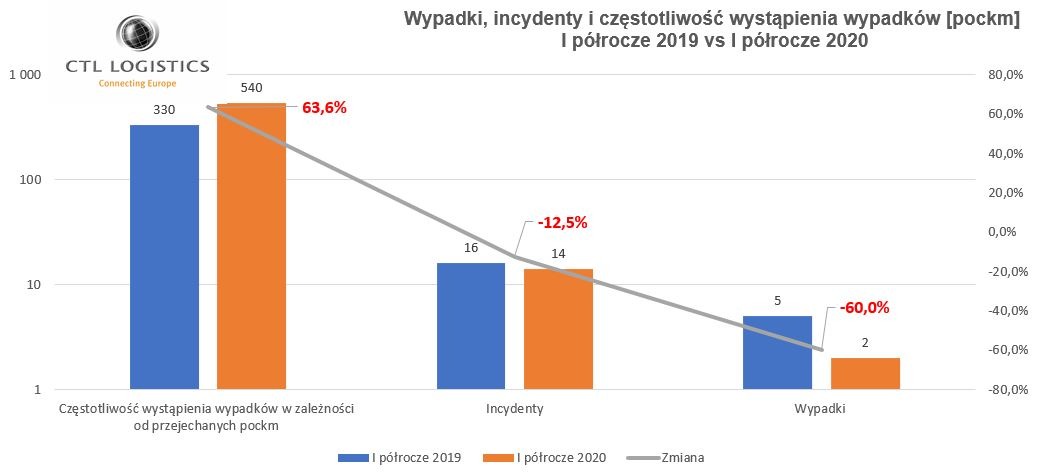Security is not numbers. These are people and specific preventive actions, therefore, from the carrier's point of view, the key is not an accident, not a collision and potentially dangerous situations. These are events that, in the event of improper behavior of employees or failure of the rolling stock emergency detection devices, may turn into incidents or accidents.
CTL Logistics analyzes in detail the causes of these events. Also in this category, the number of potentially dangerous situations (PDS) is decreasing year by year. The last 6 months has been a sustained downward trend: 277 PDS in 2020 vs 348 PDS in the same period of 2019. How did these indicators translate into the train-kilometers traveled? In the first half of this year, there is 1 PDS every 5848 train km, in 2019 every 4741 thousand train km, i.e. an improvement of the indicator by 20%.
Such a decrease in the number of PDS is mainly due to the team dealing with the operation of the rolling stock and our commissioners who perform intermediate acceptances and after repairs in factories and repair workshops. When analyzing the faults, the most numerous group are those related to the exceeded axle load and problems with the pneumatic and mechanical systems of the brake system. The malfunction of the brake usually leads to driving the car or train set in a braked state. As a further consequence, this leads to flat spots, tread buildups on railroad wheels, and wheel tread defects, which lead to the effect of dynamic overload. The main reasons for these phenomena are the incorrectly carried out loading process of the wagons, various types of control valves installed in the wagons, failures of the control valves or inadequate service of the main brake system.
What are we doing to successively reduce the number of incidents and potentially dangerous situations? According to the principle, prevention is better than cure, prevention is the basis, hence the innumerable number of trainings, findings, verification ... - field work brings results!
- Constant contact with loading companies, indicating the importance of proper loading for the safety of transport;
- Instructions for the correct loading of wagons developed in the Company are each time delivered to the Customers responsible for loading the wagons;
- Repair workshops - protocol defect verification, special supervision over the quality of repairs of elements exposed to high faults;
- Periodic instructions - detailed discussion of railway events and potentially dangerous situations during periodic instructions for employees directly related to railway traffic safety;
- Conducting audits of maintenance service providers and suppliers of components used in the maintenance process;
- Ongoing monitoring of incidents and potentially dangerous situations by analyzing the provisions of the SEPE System, made available by the Infrastructure Manager of PKP PLK S.A;
- Ongoing monitoring and supervision over the exclusion of wagons for scheduled maintenance activities;
- Preventive inspections and removal of faults during the convergence of block trains to maintenance units (in winter, drainage of brake devices in all wagons);
- Analyzing the occurrence of complaints regarding the proper performance of maintenance activities and delivered components;
- Organization of trainings for commissioners and wagon maintenance specialists in the field of technical acceptance and wagon maintenance.
A number of the above activities from year to year results in a systematic decrease in the number of occurring PDS. Fewer incidents mean increased operational capabilities, optimized resources and faster customer service. And most importantly - security.
Andrzej Pawłowski, Member of the Board of CTL Logistics, Director of Operations and Rolling Stock Maintenance: “The high level of security is a priority for the Company. This goal is achieved by meeting the required safety standards, monitoring, risk assessment, taking preventive measures and training employees. The analysis of railway traffic safety, potentially dangerous events and situations related to the technical condition of locomotives and wagons, the activity of the training and examination center for train drivers - all this is discussed in periodic instructions. In addition, we trained administrative employees in the field of knowledge of railway processes and rolling stock construction, which allowed them to look at their tasks completely differently and the impact of their performance on the operational process of the railway. The next instructions, which in a few days, we will enrich with "workshops" with ALKOgoggles, to demonstrate and make our employees aware of the impaired senses after drinking alcohol. We support the principle of "Conscious employee - greater safety on the railways".


